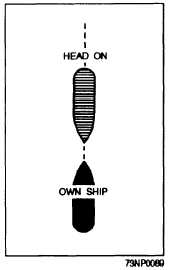Head-on Situation
When two ships meet head-on or nearly so (fig.
9-19), each ship must change course to starboard and
pass port-to-port. In international waters, a whistle
signal is sounded only when a course change is
actually made. If the meeting ships are already far
enough off from each other to pass clear on their
present courses, no signal is needed. Rule 14 of the
International Rules of the Road applies here.
Crossing Situation
When two power-driven vessels are crossing so as
to involve the risk of collision (fig. 9-20), the vessel
Figure 9-19.—Meeting (head-on) situation.
Figure 9-20.—Crossing situation.
Figure 9-21.—Overtaking situation.
9-21
having the other to starboard must keep out of the way
and will avoid, if circumstance permits, crossing
ahead of the other vessel. Rule 15 applies here.
Overtaking Situation
Any vessel overtaking another must keep clear of
the overtaken vessel. An overtaking vessel is one that
is approaching another vessel from any direction more
than 22.5° abaft its beam (fig. 9-21). When in doubt,
assume you are overtaking and act accordingly. Rule
13 applies here.
Sailing Vessel
A sailing vessel has the right-of-way over
power-driven vessels except when the power-driven
vessel is engaged in fishing, is not under command or is
restricted in her ability to maneuver. Rule 12 applies here.
Stand-on/Give-away Situation
The stand-on vessel is the vessel that stays on
course and speed. The give-away vessel is the vessel
that keeps out of the way of the other vessel. In a
head-on situation, both vessels are the give-away
vessel. Each vessel shall alter her course to starboard,
so that they will pass on the port side of each other.
Rules 16 and 17 apply here.
Take a little time and learn these rules. They will
be useful to you.





